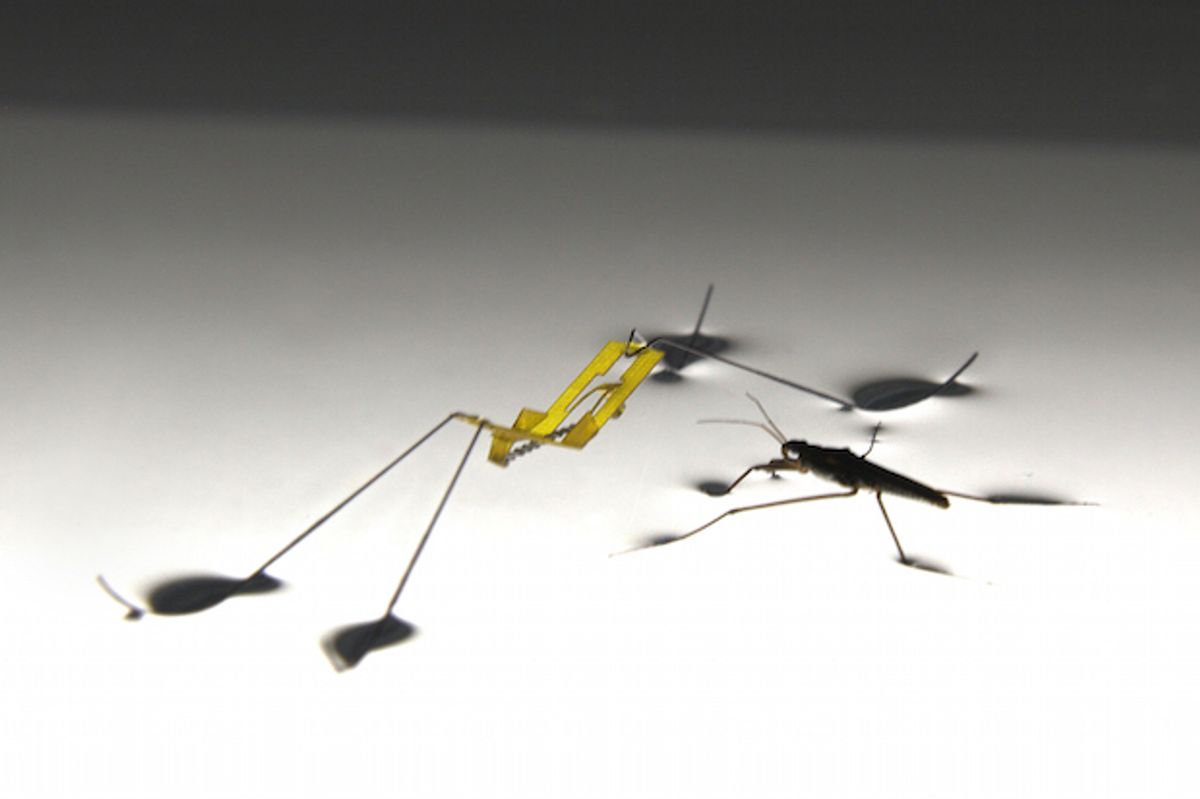Water striders are little insects that spend their existence skating around on the surface of lakes, ponds, and streams, relying on surface tension to keep them dry and happy. Watching them zip around is very cool, and its equally cool to think about the physics going on between the water and their toes to allow them to do what they do. Water striders are also able to jump, which substantially ups the difficulty on the whole not-sinking thing, since they have to somehow exert a substantial amount of force on the surface of the water without breaking through. How do they do it? South Korean researchers built a robotic water strider to find out.
Our first encounter with a water strider robot was (as far as I know) back in 2007, from CMU’s Nanorobotics Lab, which may not exist anymore. Here’s an old press release and a video:
In 2012, roboticists from Harbin Institute of Technology in China published a paper on jumping microrobots inspired by water striders, although “inspired by” might be charitable for this portly fellow:
Those feet are made of nickel foam, and although the robot weighs 11 grams, it can jump 14 centimeters high, which is quite impressive.
Now, another group of researchers has built an even more impressive robotic water strider. In a paper published today in Science, Je-Sung Koh, Eunjin Yang, Gwang-Pil Jung, Sun-Pill Jung, Jae Hak Son, Sang-Im Lee, Piotr G. Jablonski, Robert J. Wood, Ho-Young Kim, and Kyu-Jin Cho from Seoul National Univeristy and Harvard’s Wyss Institute, describe how they combined the ability to jump with a true bio-inspired water strider design and scale.

Real water striders are spectacular jumpers, and from watching slow motion videos of the insects, the researchers were able to understand how they manage it. Interestingly, water striders are able to jump just as high on water as they are on land, suggesting that the technique that they use is unique to their environment, since most other insects that can jump on water are way more efficient jumping on land. The movement of water striders is all based on using surface tension to keep themselves on top of the water’s surface, and their jumping behavior is no different.
To jump, a water strider rises upward while smoothly pushing the water surface downward and closing four of its legs inward [right]. It’s very careful not to rupture the water’s surface (doing so dissipates an enormous amount of energy and renders jumping highly inefficient), and in fact manages to exert a peak force that’s consistently just below the amount of force that would break the surface tension of the water (about 144 mN/m). By closing its legs inward, the insect is also able to pull them across the surface of the water as it begins to jump, allowing it to exert up to 42 percent more force over the surface of the water.

The 68 milligram robot (with a 2-cm body) that the researchers designed to mimic this behavior is based closely on real water strider: the wire legs are coated with a superhydrophobic material, and curve up at the toes, just like the real insect. The “muscle” that does the jumping is a bio-inspired torque reversal catapult that’s based on the leg of a flea; when it’s triggered, it applies a gradually increasing amount of torque to the legs of the robot, driving them smoothly downwards and achieving a maximum vertical acceleration of just under 14 g.
Experiments showed that the robot could leave the surface of the water with a peak velocity of 1.6 m/s, resulting in a jumping height of 142 mm. Dynamic modeling suggests that it’s exerting a force of 140 mN/m on the surface of the water, just under the 144 mN/m limit, which is ideal. The robot is also better at jumping on water than on land, possibly because the water damps leg vibrations, making the jumping more efficient.
Sadly, the researchers don’t end their paper by promising us human-scale rideable water striders robots or anything. Rather, the point of this paper was to use robots to help us better understand the biology of water strider insects, and how they can take optimal advantage of the surface tension of water to move and jump.
[ Science ]
Evan Ackerman is a senior editor at IEEE Spectrum. Since 2007, he has written over 6,000 articles on robotics and technology. He has a degree in Martian geology and is excellent at playing bagpipes.




